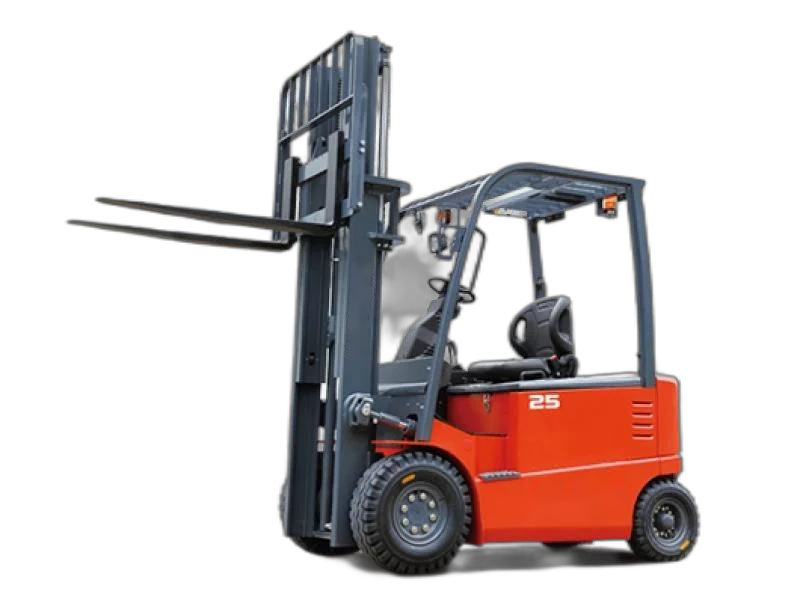Comparative Analysis of Electric Forklifts: All-round Suppression of Traditional Equipment and Manual Handling

In the field of industrial handling, electric forklifts are comprehensively surpassing internal combustion forklifts and manual handling modes with three core advantages: environmental protection, economy, and intelligence. This article reveals how electric forklifts become the optimal solution for modern logistics through multi-dimensional comparison.
I. Electric Forklift VS Internal Combustion Forklift
Comparison Dimension Electric Forklift Internal Combustion Forklift
Environmental Protection Zero emissions, noise <75dB, suitable for indoor operations Emit CO/NOx, noise >85dB, serious pollution
Energy Consumption Cost Electricity cost 0.8 yuan/kWh, save 50,000 - 70,000 yuan per year (3-ton model) Diesel 8 yuan/liter, annual energy consumption cost is 2 - 3 times higher
Maintenance Complexity No engine maintenance, annual maintenance cost reduced by 60% Need to regularly replace oil and filters, high maintenance cost
Operation Accuracy Electro-hydraulic system positioning accuracy ±2mm Mechanical transmission error >±5mm
Scene Adaptability Can be customized with explosion-proof/low-temperature versions, covering special scenarios High-temperature exhaust limits indoor use
Typical Case: After an auto parts factory replaced 10 diesel forklifts with electric forklifts:
• Annual carbon emissions reduced by 180 tons (equivalent to planting 9,000 trees)
• Equipment failure rate decreased by 55%, annual maintenance cost saved 420,000 yuan
• Warehouse air quality compliance rate increased from 72% to 98%
II. Electric Forklift VS Manual Handling
Comparison Dimension Electric Forklift Manual Handling
Handling Efficiency 3-ton goods lifted 6 meters in only 20 seconds 4 people cooperating to handle takes 5 minutes, and the weight limit <500kg
Operation Safety Triple braking + overload protection, accident rate <0.1% Human fatigue leads to an accident rate >3%
Long-term Cost About 250,000 yuan in 5 years (including equipment and energy consumption) Manpower cost over 1.5 million yuan in 5 years (calculated based on a 4-person team)
Management Difficulty Digital monitoring, utilization rate >90% High personnel turnover rate, continuous investment in training costs
Environmental Adaptability Full-climate operation from -25°C to 50°C Efficiency drops by more than 50% in extreme temperature/humidity environments
Data Evidence: After an e-commerce warehouse introduced electric forklifts:
• Daily cargo throughput increased from 800 pallets to 2,200 pallets
• Manpower cost reduced by 70%, work-related injuries reduced to zero
• Mis-picking rate decreased from 1.2% to 0.3%
III. Irreplaceable Advantages of Electric Forklifts
- Green Competitiveness
• Zero-carbon certification: Complies with EU CE, US UL and other environmental protection standards, helping enterprises improve their ESG ratings
• Silent Revolution: Noise level below 75dB, meeting the needs of sensitive scenarios such as hospitals and laboratories - Intelligent Evolution Potential
• 5G IoT: Real-time monitoring of equipment status, preventive maintenance accuracy >85%
• Autonomous Driving: Equipped with lidar to achieve centimeter-level navigation, seamless integration with WMS system - Whole Lifecycle Economy
Cost Item Electric Forklift Internal Combustion Forklift Manual Handling
Purchase Cost (3 tons) 180,000 - 250,000 yuan 120,000 - 180,000 yuan 0 (but need to continuously hire workers)
5-year Energy Consumption Cost 50,000 yuan 280,000 yuan 1.5 million yuan (labor)
Residual Value Rate (after 5 years) 35% 15% -
Calculation Example: Taking a 3-ton model working 8 hours a day as an example, the total cost of electric forklifts in 5 years is 52% lower than that of internal combustion forklifts and 83% lower than that of manual handling.
IV. Industry Application Scenario Comparison
Scenario Electric Forklift Suitability Internal Combustion Forklift Limitations Manual Handling Deficiencies
Food Cold Chain Warehouse Low-temperature version can operate at -25°C, no pollution Exhaust pollutes food, difficult to start at low temperatures Human body cannot withstand long-term low-temperature environment
Electronic Clean Room Anti-static design, electromagnetic radiation <10V/m Exhaust particles pollute clean rooms Manual handling easily generates static electricity and damages components
Port Container Yard IP66 protected motor resists salt spray corrosion Diesel engine is prone to failure due to moisture Manual handling cannot handle containers over 2 tons
Chemical Explosion-proof Area ATEX certified explosion-proof model Sparks pose explosion risks High safety hazards in manual operation
Future Trends: The Technological Moat of Electric Forklifts
- Hydrogen-electric Hybrid Power: Mass-produced models in 2025 will have a range exceeding 12 hours, completely solving charging anxiety
- AI Vision System: Automatically identify cargo size and center of gravity, loading efficiency increased by another 30%
- Shared Rental Model: Through the Internet of Things, realize cross-enterprise equipment scheduling, utilization rate increased to 95%
Conclusion
Electric forklifts build threefold competitive barriers through environmental compliance, intelligent scalability, and whole-cycle economy:
• Environmental Value: Reduce carbon tax expenditure, enhance the green image of enterprises
• Efficiency Value: One electric forklift can replace 8 - 10 handlers
• Strategic Value: Digital equipment lays the foundation for smart factories





